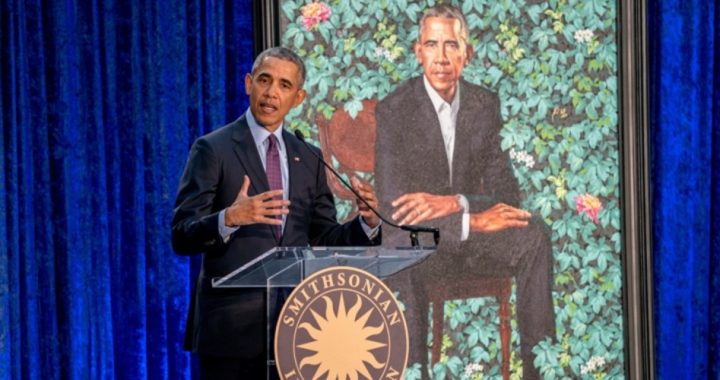
“If I had a son, he would look just like Trayvon,” then-President Barack Obama commented on the shooting of black teen Trayvon Martin by George Zimmerman. Obama’s injecting himself into a Florida criminal investigation, as president of the United States, may not have been unprecedented (President Richard Nixon was roundly criticized for his remarks about the murders of Sharon Tate by the Charles Manson gang), but it was unique in his reckless comments on the race of the parties involved.
What was not unique was that President Obama regularly raised race in local legal matters (e.g., the police acted “stupidly” in Cambridge, Massachusetts). Now that he has left the White House, it appears that this pattern will continue.
Even his portrait commissioned by the Smithsonian Institution in Washington, D.C., which will be placed in the National Portrait Gallery along with other former presidents in the “Hall of Presidents” display, has been made into a racial and cultural statement. The artist, Kehinde Wiley, a 40-year-old native of Los Angeles now based in New York, apparently is able to check the important “boxes” for the modern left-winger: Wiley is black and he is a homosexual.
And, like the man whose portrait he painted, he can fairly be called an anti-white racist.
An April 2012 piece on Wiley by New York magazine noted that the artist had anti-white paintings in his studio. One was particularly gruesome, depicting a tall black woman on an eight feet by ten feet canvas, staring intently at the viewer. (This seems to be a trait of Wiley’s — Barack Obama is also staring in the presidential portrait.) One of the woman’s hands wields a knife, while the other hand holds a severed head of a white female.
“It’s sort of a play on the ‘kill whitey’ thing,” Wiley explained.
In his fawning article in the Los Angeles Times, Christopher Knight did not mention the “kill whitey thing” portrait, but he did emphasize the racial importance of the paintings of the former First Couple. Referring to the two artists who did separate portraits of Barack and Michelle Obama, he said, “They’re the first African American artists [a black woman painted Michelle Obama’s portrait] to receive such a commission, and they are representing the first African Americans to occupy the White House.” And then, just in case enough racial commentary had not already been made, he added “which was built with slave labor.”
Knight certainly expresses a high opinion of Obama, saying he is “Olympian” in the painting, later even referring to him as “a New Adam.”
Another controversy involving the painting is that Wiley evidently has employed Chinese labor “painters” who produce mass work as part of his own work. Wiley defended the practice to New York magazine by saying that “everyone,” including Michelangelo, “has employed teams of helpers.” He explained that producing some of his work in China cuts costs.
Certainly, the practice of painting presidents has come a long way since Gilbert Stuart’s famous painting, “The Athenauem,” of George Washington (used on the one-dollar Federal Reserve note). The first president to be captured by photography was John Quincy Adams, and that was years after he had left the White House, so presidential portrait painting was once much more important than it is now.
What apparently is important now, however, is to make a political statement even with a painting. As said before, this was a pattern established while Obama was president. As Selwyn Duke wrote in The New American in the December 4, 2017 print magazine, “In 2014, the Obama administration — reacting to black and Hispanic students’ higher suspension and expulsion rates — issued new school discipline policies that essentially led to quotas in punishment…. [W]hat about the white suspension rate being significantly higher than the Asian one? About this we heard crickets — and properly so, since suspensions should be based on infractions, not the color of one’s skin.”
But that would not advance the radical agenda of Barack Hussein Obama — and make no doubt, his was and is a radical agenda. As the book, Comrade Obama Unmasked, which I reviewed for The New American, makes clear, Obama was a protégé of suspected Soviet espionage agent and Communist Party member Frank Marshall Davis, when Obama was an impressionable child growing up in Hawaii.
In one chapter of the book, Joel Gilbert, who directed the film Dreams From My Real Father, Gilbert charged that Davis was the main influence leading the young Obama to a Marxist worldview. “Frank Marshall Davis radicalized Barack Obama,” Gilbert argued.
In his own book, Dreams From My Father, Obama wrote that he went off to Occidental College “to study with Marxist professors.”
This at least partly explains Obama’s focus on race. In the Marxist view, natural divisions in society (such as race relations) are not problems to be solved; they are instead problems to be used to advance the left-wing agenda.
Even if it involves something so trivial as a presidential portrait.
Photo of President Obama with his official portrait: AP Images



